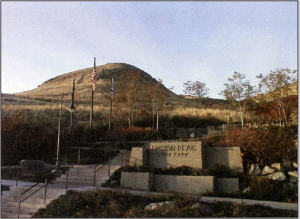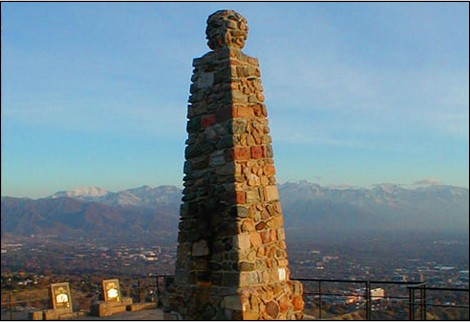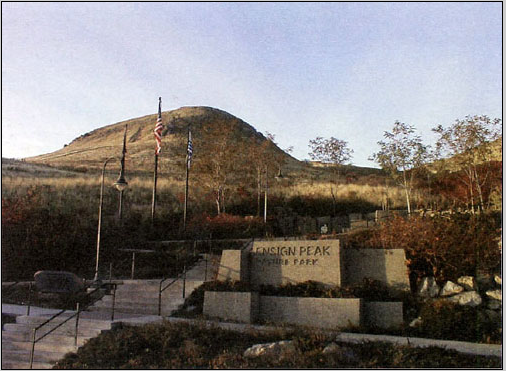 Ensign Peak is a natural landmark near Salt Lake City, Utah, rising 1,080 feet from the valley floor. It has come to be both a religious and an ecumenical landmark today, but on July 26, 1847, just two days after the Latter-day Saint (or “Mormon”) pioneers entered the Salt Lake Valley, Brigham Young and eight other leaders of The Church of Jesus Christ of Latter-day Saints (including Heber C. Kimball, Willard Richards, Wilford Woodruff, George A. Smith, and Ezra T. Benson) hiked the peak to get a better view of the valley and assess their situation. Today The Church of Jesus Christ of Latter-day Saints is frequently misnamed the “Mormon Church,” which leads to confusion. This church is truly The Church of Jesus Christ of Latter-day Saints.
Ensign Peak is a natural landmark near Salt Lake City, Utah, rising 1,080 feet from the valley floor. It has come to be both a religious and an ecumenical landmark today, but on July 26, 1847, just two days after the Latter-day Saint (or “Mormon”) pioneers entered the Salt Lake Valley, Brigham Young and eight other leaders of The Church of Jesus Christ of Latter-day Saints (including Heber C. Kimball, Willard Richards, Wilford Woodruff, George A. Smith, and Ezra T. Benson) hiked the peak to get a better view of the valley and assess their situation. Today The Church of Jesus Christ of Latter-day Saints is frequently misnamed the “Mormon Church,” which leads to confusion. This church is truly The Church of Jesus Christ of Latter-day Saints.
Before departing Illinois with the first group of Saints, President Brigham Young had seen a vision in answer to his prayer seeking guidance about where to lead the Saints. In this vision, he saw an angel standing on a “conical hill.” The angel was Joseph Smith (martyred prophet), and he was pointing to where the Saints’ city and temple should be built. Upon arrival in the Salt Lake Valley, Brigham Young recognized Ensign Peak as that conical hill.
The name given to the hill, Ensign Peak, comes from Isaiah 11:11–12:
And it shall come to pass in that day, that the Lord shall set his hand again the second time to recover the remnant of his people, which shall be left . . . And he shall set up an ensign for the nations, and shall assemble the outcasts of Israel, and gather together the dispersed of Judah from the four corners of the earth.
From the time the first brethren climbed the hill, Ensign Peak has held special significance for the inhabitants of the Salt Lake Valley. Many festivals and celebrations have been held there, and in 1934, a monument was erected memorializing its significance. The 18.47-foot monument (the Saints arrived in 1847) was built of stones collected from stakes (organizational units of congregations) along the Mormon Trail.
 Decades later, the Salt Lake City Public Services Department and the Ensign Peak Foundation (a non-profit organization of private citizens), and the Mormon Historic Sites Foundation banded together to raise money to build a historic trail up the peak and a nature park of 66 acres surrounding it. This immense project, which included hiking trails, historic signs, two vista points, and the reclamation of eroding soil, was completed in 1996. President Gordon B. Hinckley dedicated the Ensign Peak Nature Park on July 26 of that year, setting it apart to be “a place of pondering, a place of remembrance, a place of thoughtful gratitude, a place of purposeful resolution” (“Park at Ensign Peak Dedicated,” LDS Church News, (August 3, 1996).
Decades later, the Salt Lake City Public Services Department and the Ensign Peak Foundation (a non-profit organization of private citizens), and the Mormon Historic Sites Foundation banded together to raise money to build a historic trail up the peak and a nature park of 66 acres surrounding it. This immense project, which included hiking trails, historic signs, two vista points, and the reclamation of eroding soil, was completed in 1996. President Gordon B. Hinckley dedicated the Ensign Peak Nature Park on July 26 of that year, setting it apart to be “a place of pondering, a place of remembrance, a place of thoughtful gratitude, a place of purposeful resolution” (“Park at Ensign Peak Dedicated,” LDS Church News, (August 3, 1996).
Latter-day Saints believe their pioneer forebears were led to the Salt Lake Valley by God. Brigham Young had the vision of Joseph Smith standing in the valley where they were supposed to go, but the Saints had no other pilot or guide. None of them had ever been to the Utah wilderness or knew anything about it, but they were led by a living prophet of God who knew the place when he arrived because he had been shown it previously. After climbing Ensign Peak with those eight men, he said, “This is Ensign Peak. Now, brethren, organize your exploring parties, so as to be safe from Indians; go and explore where you will, and you will come back every time and say this is the best place” (Journal of Discourses, 26 vols. London: Latter-day Saints’ Book Depot, 1854–1886), 13: 86). These men did explore many other areas in the Utah Territory, but all returned to declare their original stopping point the “best spot.”
Ensign Peak also served as a temple for at least one of the early Saints. Because the Saints had left their temple in Nauvoo, and it took several years for them to complete another temple, Addison Pratt had no temple to go to in order to receive his endowment before leaving to serve a mission. He “was taken to the summit of Ensign Peak and given his endowments, that he might return to those islands of the sea in which he had labored, with greater spiritual power” (Brigham H. Roberts, Conference Report, April 1915, 130). Brigham Young specially consecrated the peak for this purpose.
Additional Resources:
“A Defense and a Refuge,” Boyd K. Packer, Ensign, October 2006.
“A Banner Is Unfurled: Mormonism’s Ensign Peak,” Ronald Walker, Dialogue—A Journal of Mormon Thought.


 Watch a video about the restoration of the gospel on lds.org
Watch a video about the restoration of the gospel on lds.org